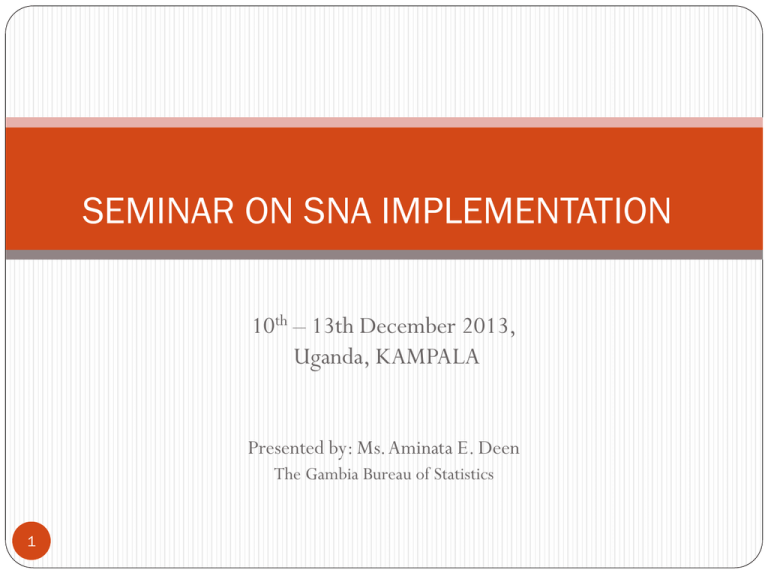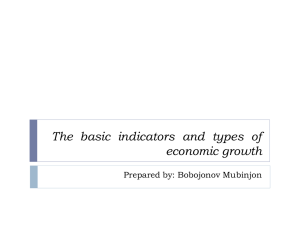At current price - United Nations Statistics Division
advertisement

SEMINAR ON SNA IMPLEMENTATION 10th – 13th December 2013, Uganda, KAMPALA Presented by: Ms. Aminata E. Deen The Gambia Bureau of Statistics 1 Outline of the Presentation Background: (overview of the Gambian Economy (recent economic developments) Policy issues (relationship with the national accounts framework) Current Status of compiling (producing annual GDP estimates) Compilation by Economic Activity (Data Sources and Methodology) Conclusions: -constraints and challenges Way Forward: -areas for improvement 2 Economic Profile 3 The Gambian economy performed well in recent years, with robust growth and low inflation, despite the global financial crisis and major shocks to fuel and food prices. However, tourism and residential construction (financed by remittances) were hit hard by the global crisis. The economy is largely agriculture with about 80% of the population engaged in farming. On average, Agriculture contributes about 30% to the GDP while Industry and Services accounts for 12% and 57% respectively. GDP per capital was estimated at $544 as at end Dec. 2012. During 2007–2010, real GDP growth averaged around 5.5 percent a year, driven mainly by a strong expansion in agriculture and services, including financial services and telecommunications. Economic Profile contd’ In 2011 however, growth was estimated to have fallen to about 4.3 percent, owing to the initial effects of a crop failure during the 2011-12 crop season. In 2012, a strong rebound in the agriculture and tourism sectors helped to moderate the decline in the 2011 and the economy registered a significant growth of 6.1 percent Inflation averaged around 5 percent a year during 2007- 2012, as the Central Bank of The Gambia (CBG) generally maintained a restrained monetary stance over the years. 4 Economic Profile contd’ Although the external current account deficit widened in recent years, official international reserves remained at a comfortable level, (partly because of the IMF’s SDR allocation in 2009). As of the end of 2011, gross reserves was equivalent to 5.1 months of imports cover. Strong economic growth, particularly in rural areas, contributed to a significant reduction in poverty. Based on the 2010 household income & expenditure survey, the headcount poverty index, based on a poverty threshold of USD 1.25 a day, fell to 48.5 percent in 2010, compared with 58 percent in 2003. 5 Economic Profile contd’ Despite these positive developments, the Government’s debt burden continued to weigh heavily on the economy and the country remains at high risk of distress on its external debt. The Government’s domestic debt (about30 percent of GDP) at the end of 2011, also poses high risks, as three-fourths of the debt was in the form of T-bills with maturities of one year or less, creating very high roll over risks. Moreover, interest on domestic debt has been very high, consuming about 18 percent of government revenues in 2011. 6 Economic Profile contd’ In recent years, domestic debt has been rising (relative to GDP), as government revenues fell steadily from 17.3 percent of GDP in 2007 to 14.9 percent of GDP in 2011, while episodes of severe spending overruns resulted in large fiscal deficits. In 2010 particularly, the Government’s net domestic borrowing (NDB) rose to (4.7 percent of GDP), leading to increased pressures on inflation, interest rates, and the exchange rate. 7 Main Policy Issues The primary role of government is to develop policies that encourage growth in order to promote the society’s economic well being. The Gambia Government is thus committed to reducing poverty and improving the well-being of its population; this commitment is driven by Vision 2020, which is being executed through a series of medium-term development strategies.(The PRSP I &11, now the PAGE). The Programme for Accelerated Growth and Employment (PAGE) is The Gambia’s new development strategy and investment programme for 2012 to 2015. 8 Main Policy Issues contd’ PAGE is the main interface between the Government and The Gambia’s development partners and is fully aligned with the Millennium Development Goals (MDGs). PAGE priorities include support for agriculture, education, health, and stepped-up investment in infrastructure. To this effect, a policy agenda document the MEFP was established by the IMF and The Gambia Government in which the improvement of quality economic statistics was emphasized. 9 Main Policy Issues-Cont’d Given the constrained resource envelope for PAGE period, and the continued high risk of debt distress, the Government has launched a sustained effort to engage other development partners and attract support. Highlighted in the PAGE, macroeconomic stability is essential for achieving high growth rates and increased employment. In this context, continued progress on reducing the burden and risks associated with the Government’s domestic debt will be the anchor to the macroeconomic policy framework over the medium term. 10 Main Policy Issues- (relationship to national accounts framework) To allow the implementation of PAGE, the Government is now in the process of reforming its macroeconomic sector. Regarding the fiscal framework, the Government has introduced a Value Added Tax (VAT) system in the Gambia, a Medium Term Expenditure Framework (MTEF) and a more comprehensive Programme Based Budgeting (PBB) system. Monetary policy has been designed to keep inflation in the low 11 single digits. For the real sector, the Government will increase investment in agriculture from about 6 per cent of domestic resources in 2011 to 10 per cent during the PAGE period. Main Policy Issues- (relationship to national accounts framework) The macro model. The Macroeconomic Policy Analysis Unit (MPAU) of the Ministry of Finance and Economic Affairs has developed, an “Operational Consistent Macroeconomic Accounting Spreadsheet Model” for the Gambian economy. The analytical framework is consistent with the basic concepts and interrelations under the UN System of National Accounts (UNSNA), and the IMF Government Finance Statistics (GFS), Balance of Payments (BOP) Statistics, and the MonetaryFinancial Statistics (MFS). 12 Main Policy Issues- (NSDS I) The Gamba NSS witnessed during the last decade important institutional reforms and the undertaking of key activities which included the following: The drafting and adoption of a new Statistical Act of 2005 replacing the 1972 Act; The preparation and adoption of the Strategic Plan for the development of Statistics ( first generation of NSDS I); The conduct of an economic census in 2006; The conduct of an Integrated Household Survey; With these two main activities, The creation of The Gambia Bureau as a semi-autonomous institution in 2005 and the rebasing of both the National Accounts and the CPI 13 Status of Producing Annual GDP Estimates 14 In the Gambia, given the resources and the data currently available, the National accounts framework could not be fully implemented; focus has been on ensuring GDP (one of the main aggregates) and its main components are measured in the most appropriate way. As far as possible, the estimates of GDP are compiled in accordance with the principles and concepts of the SNA93. In 2004/05 The Gambia Bureau of Statistics (GBoS) conducted a Census of the Gambian economy which provided the statistics necessary to compile a new benchmark to determine the level of GDP. In the same vein, an Integrated Household Survey (IHS) was also conducted in 2003/04 with the main objective of rebasing the Consumer Price Index (CPI). Status of Producing Annual GDP Estimates Cont’d 15 The economic census thus provided benchmark data for compiling annual GDP using the production approach and also made it possible for migrating from SNA68 to SNA93. The IHS which provided data for rebasing the CPI also provided the first opportunity for independently estimating GDP using the expenditure approach. The old GDP series of 1976/77 benchmark (SNA68) has now been replaced by an up to date base 2004 and is in line with the SNA93 while the old CPI series of 1974 base has also been revised to 2004 base. Status of Producing Annual GDP Estimates Cont’d 16 Annual estimates of GDP are compiled by estimating the GVA for each branch of activity in the economy, both in current prices and in constant (2004) prices. Benchmark estimates of the value of output for each activity are based primarily on the information obtained from the Economic Census questionnaires that were designed for the various economic activities (except for crop production and public administration). Estimates are available for each activity on the: Total output, Intermediate consumption, and Gross value added. Once the estimates of GVA by activity were computed, two adjustments were made in order to convert total GVA at basic prices into GDP at market prices for both current and constant. The first is FISIM and the second is taxes (less subsidies) on products. FISIM is thus subtracted from the total gross value added while taxes less subsidies on products is added. Estimating GVA by activity at current prices The procedure used for estimating GVA at current prices is as follows: -First, the benchmark total output figures are extrapolated using the appropriate value index to obtain estimates of total output at current prices (TOCP). -Next, the appropriate input-output ratio (derived from the 2004 economic census) is applied to the total output to estimate intermediate consumption (IC) at current prices. -Finally, the IC is subtracted from TOCP to give the gross value added at current prices (GVA CP). 17 Estimating GVA by activity at 2004 constant prices Estimating GVA at constant prices for most activity is done by a direct method. This method is simply to extrapolate the benchmark GVA using the appropriate quantity index. That is equivalent to extrapolating the benchmark total output by the quantity index and applying the benchmark input-output ratio in every year to derive the GVA. 18 Data sources and compilation Agriculture Crop Production Sources: Data on quantities and prices for each of the main crops grown in the Gambia are obtained from the Ministry of Agriculture through their annual National Agricultural Sample Survey (NASS); Data on horticultural products were obtained from the Economic Census but for 2004 only; Method:To derive the current price estimates, the quantity of crops produced in each year (in metric tonnes) is multiplied by its’ relevant unit price collected from the Consumer Price Index (CPI). This is summed and converted to a value index of which is applied to the total output for crops in the base year (2004). At constant price, estimates are derived by applying the 2004 prices to the quantity figures for each year. It is then summed, converted to a volume index which is applied to the total output of the base year. Intermediate consumption (IC) at current and constant prices for all years are derived by applying the factors for the 2004 benchmark estimates. 19 Data sources and compilation cont’d Livestock Sources: Department of Livestock Services and the (National Agricultural Sample Survey report (NASS) provide figures on number of livestock by type. Method: At constant price: The quantities for each type of animal are converted to a volume index with the year 2004 made equal to 100. An overall volume index is then derived as the simple average of the indices for each type of animal and is used to extrapolate the current year figure. At current price: A similar approach is used to derive an overall price index for livestock. That is, a unit price for each type of meat is converted to a price index based on 2004. An overall price index is thus obtained as a simple average of the individual indices which is applied to the quantity index and used to extrapolate the current year’s estimates. 20 Data sources and compilation cont’d Forestry Sources: The 2003/04 Integrated Household Survey (IHS) provided data on fuel wood and charcoal consumption; The Department of Forestry provides estimates of revenues collected for the various types of forestry products. Method: At current price: output of the forestry sub-sector for 2004 is based on household expenditure on forestry items derived from the 2003/04 HIS and for subsequent years’ based on revenue collected from forestry product. At constant price: indicative growth rates are applied in consultation with the department of forestry. 21 Data sources and compilation cont’d Fishing Sources: Department of Fisheries provides estimates on quantities of fish catches; Method: At current price: the output for fish in a current year is derived by applying the quantity index of fish catches to the CPI sub-index for fish in the same period. At constant price: output is extrapolated by applying the quantity index to the output of the base year. Intermediate consumption at current and constant prices is derived using the ratio of input to gross output for 2004 22 Data sources and compilation cont’d Mining and Quarrying Source: Department of Geology provides production data for sand, gravel and clay Method: At current price: total quantity for each of these products were multiplied by its’ price prevailing in the market to derive the value of output. Value index were constructed and applied to the benchmark figure to derive total output for the current year. At constant price: total output is extrapolated using the quantity index of the products. For both current and constant price, Intermediate consumption 23 is derived using the ratio of inputs to gross output for 2004. Data sources and compilation cont’d Manufacturing 24 Sources: Economic Census and annual data on production and sales are collected from few large establishments engaged in manufacturing of various products Method: At current price: the gross output and intermediate consumption were obtained from the Economic Census benchmark year (2004). Subsequent year’s estimates are based on annual turnover of these establishments and are converted to value index. Total output for each year at current price is then extrapolated using the value index. At constant price: total output is derived by deflating with the CPI. For both current and constant price, Intermediate consumption is derived using the ratio of inputs to gross output for 2004. Data sources and compilation cont’d Electricity andWater Sources: The annual accounts and reports of the National Water and Electricity Company (NAWEC). Method: At constant price: total output is derived by applying the quantity index for both electricity & water to the benchmark output value. At current price: total output is derived by multiplying the constant value estimates with the CPI sub-index for electricity & water. For both current and constant price, Intermediate consumption is derived using the ratio of inputs to gross output for 2004. 25 Data sources and compilation cont’d Construction Sources: Data is obtained for quantities and value of imports on construction materials from the external trade unit of GBoS. Method: At current price: total output for each year is extrapolated with the value index for imports of construction materials. At constant price: the output of current price series is deflated with the all item CPI. 26 Data sources and compilation cont’d Wholesale & Retail Trade Sources: Ministry of Finance fiscal tables data on domestic taxes, taxes on international trade and excise duties is extracted. Method: At current price: for the years 2005-2009 estimates are based on the value index of domestic taxes, taxes on international trade and excise duties. For the most recent years, estimates are based on changes in the sum of imports of goods and gross output for the agriculture, fishing and manufacturing industries. The constant price estimates are derived by deflating the current price by the all item CPI. 27 Data sources and compilation cont’d Hotels & Restaurants Sources: Data on the number of tourists visiting the Gambia annually is provided byThe Gambia Tourism Board. Method: At constant price: The quantity index of the total number (for the total number of tourist visiting each year) is applied to the benchmark. At current price: output is derived by applying the quantity index and the CPI sub-index for hotels & restaurants to the benchmark; For both current and constant price, Intermediate consumption is derived using the ratio of inputs to gross output for 2004. GVA estimated as Gross Output minus Intermediate Consumption. 28 Data sources and compilation cont’d Transport & Storage Sources: Economic Census, police headquarters, GBoS Transport Unit Method: At constant price: output is derived by applying the quantity index (of the total number of registered commercial vehicles) to the benchmark; At current price: the CPI sub-index for transport is applied to the benchmark For both current and constant price, Intermediate consumption is derived using the ratio of inputs to gross output for 2004. GVA estimated as Gross Output minus Intermediate Consumption. 29 Data sources and compilation cont’d Communication & Postal Services Sources: The Gambia Telecommunications Company Limited (GAMTEL) and four other GSM cell phone operators Method: At constant price: output is derived for 2005-2008 by applying the volume index of fixed landlines to the benchmark. For recent years the volume of call minutes for fixed lines and GSM was applied. At current price: output is derived by applying the quantity index and the CPI sub-component for communication to the benchmark. For both current and constant price, Intermediate consumption is derived using the ratio of inputs to gross output for 2004. GVA estimated as Gross Output minus Intermediate Consumption. 30 Data sources and compilation cont’d Finance & Insurance Sources: Data is provided by the Central Bank of the Gambia on the annual profit & loss statement of the commercial banks and Insurance companies. Method: At current price: Gross output is derived as net interest income plus fees and charges for specific services; at constant price: it is deflated by the overall CPI to derive output. For insurance industry, output at current price is equal to the gross premium; this is also deflated with the overall CPI to derive the constant price. Intermediate consumption at current and constant prices is calculated for the combined financial intermediation and insurance industry using the ratio for the year 2004. 31 Data sources and compilation cont’d Real Estate, Renting & Business Activities: Sources: : Economic Census, the Integrated Household survey (IHS). Method: The constant price estimates for the real estate, renting and business activities, output is derived by applying growth in the size of the population to the 2004 benchmark estimate. The current price estimate for gross output is then obtained by applying the housing sub-component of the CPI to the volume estimates. Intermediate consumption at current and constant prices is calculated using the ratio for the year 32 Data sources and compilation cont’d Public Administration Sources: The main source of data is from the Ministry of Finance’s Fiscal table and the Directorate of Treasury. Method: : Output at current prices for the 2004 benchmark to date is derived from Government’s fiscal table; it is equal to total government expenditure on wages and salaries. The constant prices estimates are derived by applying growth in the total number of employees in the civil service to the 2004 base year value (excluding staff in the education and health sectors). 33 Data sources and compilation cont’d Education Sources: Budget document from the Ministry of Finance Method: The constant price estimates for education is derived by applying growth in the number of employees in the education sector. The current price estimates is then derived by applying the CPI sub-component for education to the corresponding volume estimates. 34 Data sources and compilation cont’d Health & Social Work Sources: Budget document from the Ministry of Finance Method: The constant price estimates for health is derived by applying growth in the number of employees in the health sector. The current price estimates is then derived by applying the CPI sub-component for health to the corresponding volume estimates. 35 Data sources and compilation cont’d Other Community, Social & Personal Services Sources: Budget document from the Ministry of Finance Method: The constant estimates for the other community, social and personal services industry is derived by applying growth in the size of the population to the 2004 benchmark estimate for gross output. The current price estimate for gross output is then obtained by applying the CPI sub-component for recreation to the volume estimates. Intermediate consumption at current and constant prices is calculated using the ratio for the year 2004. 36 ADJUSTMENTS For FISIM, the current price estimates are the actual figures reported by the Central Bank of The Gambia and taken to be the net-interest income. The constant estimates for FISIM is derived by deflation using the total CPI. Taxes less subsidies on products: Taxes on products at current prices is obtained from the finance ministry’s fiscal table were figures for sales tax, excise duties and taxes on international trade are extracted. The volume estimates are derived by applying the growth in total value added at constant prices to the 2004 benchmark estimate. 37 THE EXPENDITURE APPROACH Household final consumption (HFC) The estimate was derived from the Integrated Household Survey report for the benchmark year of 2004. Non-profit Institutions Serving Households Derived from the Economic Census data for the benchmark year, 2004. 38 The Expenditure Approach Cont’d Central Government consumption Obtained from corresponding budget documents for all the years. Gross fixed capital formation (GFCF) The census collected data on establishments’ acquisitions of GFCF. As part of the census reprocessing, these figures were grossed-up for all of the industries for which production data were available. For the few industries without any figures for GFCF, estimate of capital formation were assumed to follow rates of the responding establishments. In addition, GFCF figures for central government were extracted from the budget statement for 2004. 39 The Expenditure Approach Cont’d Changes in inventories Estimates for changes in inventories have been produced from the economic census. Exports less imports of goods and services The imports and exports are obtained from GBoS and, data pertaining to two-way flow of services were obtained from the Central Bank of The Gambia. 40 CONCLUSION: Constraints & Challenges 41 Producing a revised national accounts and CPI series, there still exists a number of critical issues hampering the effective production of annual GDP estimates, among these : Low level capacity/academic qualifications of the current statisticians involved in compiling/producing annual GDP estimates; No focus on routine data collection and as a result there are data gaps in some sectors; The lack of resources to undertake annual establishment surveys and the maintenance of a comprehensive business register (to serve as a frame for subsequent economic surveys) makes it difficult to properly maintain regular economic series; Weak coordination of the National Statistical System, poor communication with stakeholders – sharing information problems especially from some sectors responsible for data collection for inputs into GDP; e.g. agriculture Way Forward-NSDS II There is a need for constant training and capacity building in national accounts and economic statistics related subjects for the staff of this unit.(both short and long term); The need to secure sustainable funding – (from the Government of The Gambia as well as from Development Partners), to put in place an annual data collection exercise for the manufacturing and construction activities, wholesale & retail trade, hotels & restaurants, real estate and other business activities; To put in place a comprehensive list of business establishments to be used as a frame for subsequent economic surveys and it should be constantly updated; 42 Way Forward The cost of tools and implements used in agricultural production as well as farm-gate prices for various crops should be collected requiring the expansion in the coverage of the Producer Price Index. This will enable the national accounts unit to apply double-deflation method for compilation of Value Added for agriculture in conformity with international standards; Efforts have to be made to also collect livestock figures directly from farmers, animal slaughters in the abattoirs as well as those exported regular livestock surveys is to be carried out by the Department of Livestock Services; Conduct an intensive data collection of indicators on Forestry products; Finally, conducting another phase of an economic census is very crucial to improving the annual GDP estimates as well as provide a new benchmark which should be in line with the 2008 SNA. 43 End of Presentation Thank you for your attention 44






